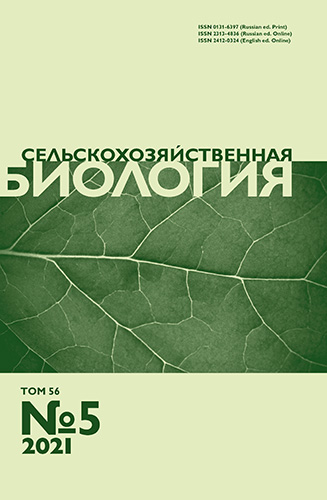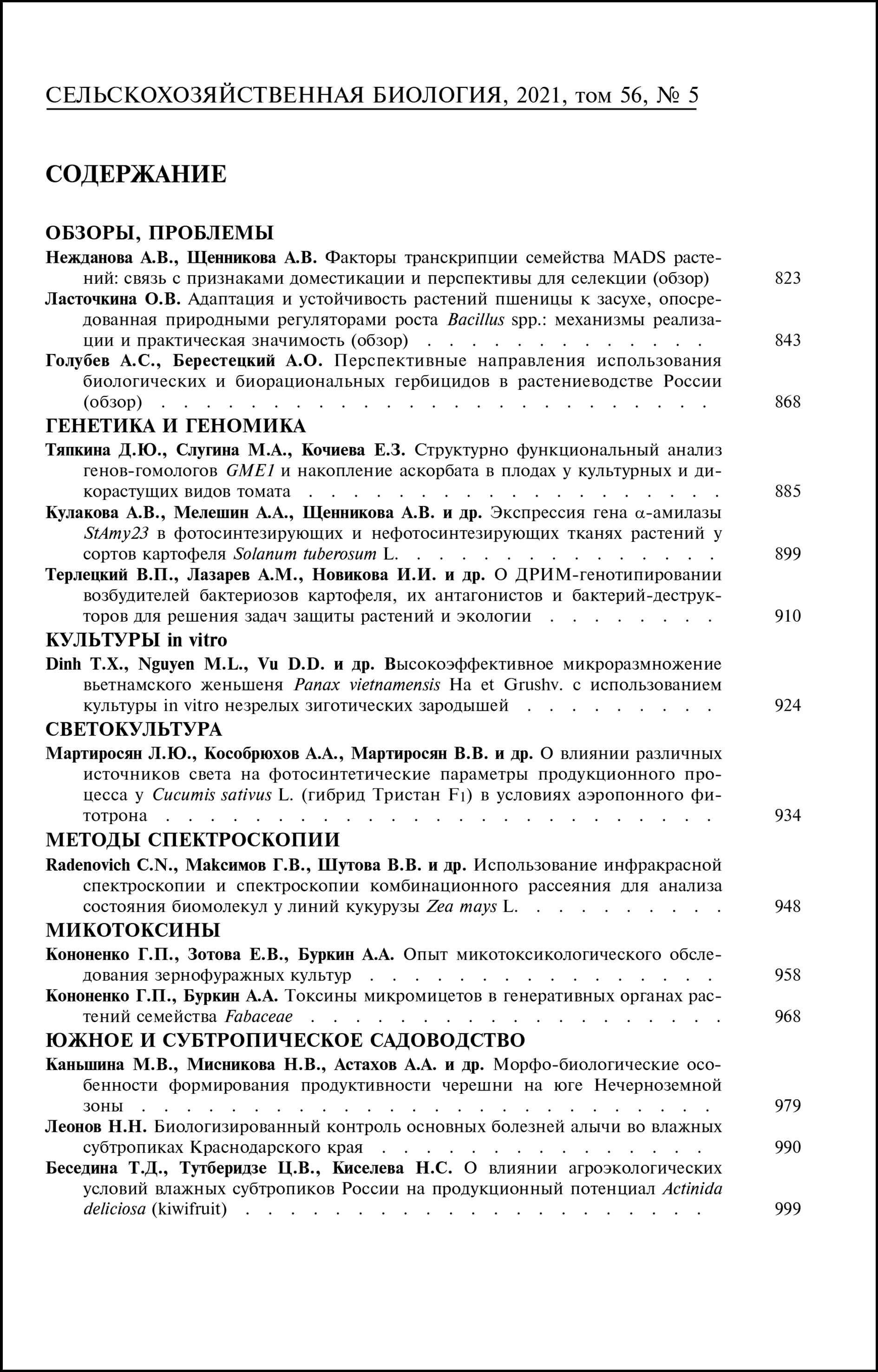doi: 10.15389/agrobiology.2021.5.868rus
УДК 632.93
ПЕРСПЕКТИВНЫЕ НАПРАВЛЕНИЯ ИСПОЛЬЗОВАНИЯ БИОЛОГИЧЕСКИХ И БИОРАЦИОНАЛЬНЫХ ГЕРБИЦИДОВ В РАСТЕНИЕВОДСТВЕ РОССИИ (обзор)
А.С. ГОЛУБЕВ ✉, А.О. БЕРЕСТЕЦКИЙ
Появление резистентных к химическим гербицидам популяций сорных растений приводит к повсеместному снижению эффективности использования таких препаратов. Несмотря на то, что в Соединенных Штатах Америки, Канаде, Китае и Южной Африке на рынке средств борьбы с сорной растительностью внедряются биологические и биорациональные гербициды (БГБ), в Российской Федерации к настоящему моменту не зарегистрировано ни одного подобного препарата. В то же время развитие исследований по разработке экологически безопасных средств борьбы с сорными растениями позволяет рассчитывать на изменение существующей ситуации (А.О. Берестецкий, 2017; M. с соавт., 2020). Цель настоящего обзора — анализ современного ассортимента химических гербицидов, разрешенных для применения в России, для выявления рыночных ниш, которые могут занять биологические и биорациональные гербициды в ближайшем будущем. Для оценки перспектив использования БГБ в первую очередь учитывали спектр их действия, обусловленный видовой специфичностью фитопатогенов, который значительно уже спектра гербицидов химического синтеза (A. Berestetskiy с соавт., 2018; A. Berestetskiy, 2021). В основу анализа был положен перечень особо опасных для продукции растительного происхождения вредных организмов, подготовленный Всероссийским НИИ защиты растений (2013), в котором указаны следующие виды сорных растений: осот полевой (Sonchus arvensis L.), бодяк щетинистый (Cirsium setosum (Willd.) Bess.), вьюнок полевой (Convolvulus arvensis L.), пырей ползучий (Elytrigia repens (L.) Nevski) и овсюг обыкновенный (Avena fatua L.). Перечень был дополнен двумя карантинными сорняками, ограниченно распространенными на территории Российской Федерации, но проблемными для ряда регионов, — амброзией полыннолистной (Ambrosia artemisiifolia L.) и горчаком ползучим (Acroptilon repens DC.). Указанные виды сорных растений обладают неодинаковой степенью вредоносности на разных культурах (А.М. Шпанев, 2011). В анализе были задействованы наиболее значимые с точки зрения структуры посевных площадей Российской Федерации сельскохозяйственные культуры. Наиболее перспективно применение БГБ в садах и виноградниках, где, в связи с исключением препаратов на основе глифосата, разрешено использовать лишь глюфосинат аммония (А.С. Голубев с соавт., 2018; А.С. Голубев с соавт., 2019). Кроме того, БГБ, применяемые совместно с этим гербицидом, позволили бы увеличить эффективность обработок и продолжительность защитного эффекта. Риски использования БГБ в садах и виноградниках не выглядят значимыми из-за относительной замкнутости этих агроэкосистем. Кормовые культуры и овощи закрытого грунта не имеют существенного потенциала в качестве ниш для применения БГБ: кормовые культуры — из-за низкой экономической отдачи, а овощи закрытого грунта — ввиду особенностей технологии их выращивания. Перспективным выглядит использование БГБ на полях, предназначенных под посев сельскохозяйственных культур, в осенний период и на паровых полях. В условиях севооборотов БГБ могут использоваться против многолетних корнеотпрысковых сорняков и горчака ползучего в период вегетации сои, подсолнечника и картофеля. На двух последних культурах БГБ могут применяться против амброзии полыннолистной. Занять нишу, связанную с уничтожением злаковых сорных растений (таких как пырей ползучий или овсюг), в условиях сложившегося ассортимента химических гербицидов, будет возможно только для подавления резистентных популяций сорняков.
Ключевые слова: биогербициды, зерновые, кукуруза, соя, подсолнечник, картофель, сады, Sonchus arvensis, Cirsium setosum, Convolvulus arvensis, Elytrigia repens, Avena fatua, Ambrosia artemisiifolia, Acroptilon repens.
FUTURE DIRECTIONS FOR USE OF BIOLOGICAL AND BIORATIONAL HERBICIDES IN RUSSIA (review)
A.S. Golubev ✉, A.O. Berestetskiy
The emergence of weed populations resistant to chemical herbicides leads to a widespread decrease in the effectiveness of the chemical control. This fact, along with the currently increasing consumer demand for organic food, leads to an awareness of the need to develop research on the development of biological means of protecting crops from weeds. Despite the fact that biological (BLH) and biorational herbicides (BRH) are being introduced in the market of weed control products in the United States, Canada, China and South Africa, no such products has been registered in the Russian Federation to date. At the same time, the development of research on the development of environmentally friendly means of weed control allows to count on a change in the existing situation in the foreseeable future (A.O. Berestetskiy, 2017; M. Triolet et al., 2020). The purpose of this literature review was to analyze the current range of chemical herbicides allowed for use in Russia in order to identify market niches that BLH and BRH may occupy in the near future. To assess the prospects of these products, first of all, the spectrum of their action was taken into account, due to the species specificity of plant pathogens, which is significantly narrower than the activity spectrum of chemical herbicides (A. Berestetsky et al., 2018; A. Berestetsky, 2021). The analysis was based on a list of pest organisms that are particularly dangerous for crops prepared by the All-Russian Research Institute for Plant Protection (2013), in which the following types of weeds were indicated: perennial sowthistle (Sonchus arvensis L.), Canada thistle (Cirsium setosum (Willd.) Bess.), field bindweed (Convolvulus arvensis L.), couch grass (Elytrigia repens (L.) Nevski), and wild oat (Avena fatua L.). The list was supplemented with two quarantine weeds, common ragweed (Ambrosia artemisiifolia L.) and Russian knapweed (Acroptilon repens DC.), which are limited in the territory of the Russian Federation, but are problematic for a number of regions. These types of weeds have different degrees of harmfulness in different crops (A.M. Shpanev, 2011). The analysis involved the most significant agricultural crops from the point of view of the structure of the arable land of the Russian Federation. The use of BLH and BRH seems most promising in orchards and vineyards, where, due to the exclusion of glyphosate-based herbicides, only gufosinate-ammonium is allowed for use (A.S. Golubev et al., 2018; 2019). In addition, BLH and BRH, used in combination with some herbicides, would increase the effectiveness of weed control and the duration of the protective effect. The risks of using BLH and BRH in orchards and vineyards do not look significant due to the relative isolation of these agroecosystems. Forage crops and greenhouse vegetables do not have much potential as niches for the use of BLH and BRH, forage crops due to low economic returns, and vegetables in greenhouses due to the peculiarities of their cultivation technology. The use of BLH and BRH in fields intended for sowing agricultural crops in the autumn period and in fallow fields looks promising. In the conditions of crop rotations, BLH and BRH can be applicable against perennial root-sprouting weeds and Russian knapweed during the growing season of soybeans, sunflower, and potatoes. For the last two crops, the use of BLH and BRH against common ragweed looks promising as well. It will be possible to occupy a niche associated with the destruction of grass weeds (such as couch grass or wild oat), in the conditions of the existing range of chemical herbicides, only for the suppression of resistant weed populations.
Keywords: bioherbicides, cereals, corn, soybean, sunflower, potato, orchard, Sonchus arvensis, Cirsium setosum, Convolvulus arvensis, Elytrigia repens, Avena fatua, Ambrosia artemisiifolia, Acroptilon repens.
ФГБНУ Всероссийский НИИ защиты растений, |
Поступила в редакцию |












